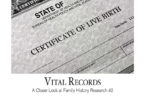The next thing you should be looking at in your family history research, as a beginning genealogist, is the US Federal census collection. This collection is considered almost as fundamental a source to beginning genealogists in the United States as are vital records. You can easily access digitized and indexed images of the census on websites like Ancestry.com, FamilySearch.org, Genealogybank.com, and others. It is also available for free on microfilm with accompanying index books at most genealogy libraries, and at the National Archives in Washington, D.C.
What is so great about the US federal census? It tells you who was living in a household at the time the census was taken. In the United States, the census is taken every ten years, on the year that ends in a zero. It began in 1790, and is still going on every ten years to this day. US federal census records are released to the public seventy-two years after they were originally taken. This means that all US federal census records from 1790 to 1940 are available to the public right now, and the 1950 US federal census will be released to the public in April of 2022.
In the census records from 1790 to 1840, only the names of the heads of the household were included in the census. Everyone else was basically a checkmark under a column listing whether someone else in the household was male or female, and what age category they fell into. Some of the earlier censuses also listed whether someone was black, and if black, free or enslaved. If you know anything about your ancestors from those decades, you can sometimes figure out who was who based on the checkmarks. If not, those checkmarks will give you potential spouses, children, and other relatives to look up and if you’re lucky, discover.
After 1840, the names of everyone in the household began being listed in the 1850 census and onward. This allows you to find out the names of more of the people in your family. The ages were also listed beginning with the 1850 census, which can assist you in locating that person in subsequent census records and in vital records.
In later censuses, even more information on each person listed was added. Depending on the census, you can find such things as the person’s birthplace, birth date, birth places of both of their parents (extremely helpful in finding earlier generations even without their names), whether someone was naturalized or a resident alien, when they came to America, whether they were married, how long they had been married, what their job was, whether they could read or write, whether they were disabled or a veteran (and of which war), whether they attended school in the past year, whether they were unemployed in the past year and for how long, whether they lived in a farm or a house, whether they rented or owned their home, and how many children a woman had given birth to along with how many were still living (also extremely helpful in furthering the names on your family tree).



